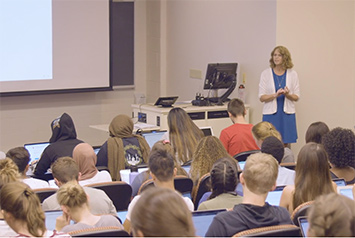Walking into a lecture hall of over 200 students can be daunting for a young undergraduate, especially when that class is centered around conducting statistical analyses of biological data. Laura Kubatko, a professor at The Ohio State University, teaches Statistics for the Life Sciences and is well aware of the apprehension that students feel.

Kubatko’s class serves as many students’ first real experience with statistical computing, including how to make statistical graphs, perform statistical analyses and utilize the appropriate software. To create a streamlined and cohesive learning environment, Kubatko began to search for something she could utilize with a large group of students on their university-issued iPads that would provide them all with the same online computing environment.
Kubatko was introduced to the Ohio Supercomputer Center’s (OSC) Open OnDemand resource by a computing administrator within her department. Open OnDemand allows users to access high performance computing (HPC) resources via a web browser on their device. This gives students the opportunity to access R on their iPads and enables instructors to control the interface and what students see when they log in.
“When they log in to the OnDemand server through OSC on their iPads, they all see exactly the same thing. We can write laboratory exercises and write hints for homework problems and this helps them have a standardized environment and know what to expect when they use the tool,” Kubatko said.
Additionally, without the need for software installation, students are able to access the R program from their iPad wherever they are and in turn are not confined to working in an on-campus computer lab.
Having control over the learning environment has allowed Kubatko to conduct practice exercises in larger groups, eliminating discrepancies that can arise in the computing environment when there are multiple sessions of the same course with different teaching assistants. While each student works independently, Kubatko is able to take their results and display them in real-time to the whole class through the interface.
Kubatko noted that the utilization of OSC resources is something that excites students. She believes that the sooner students are introduced to HPC and R software, the less daunting it will be as they continue progressing toward their career.
“What’s great about it is that it brings a widely used tool for statistical analysis of biological data to every student, basically for free, and lets them experiment with it,” Kubatko said. “We’ve had a really good response overall. We’ve gotten a bunch of emails from students that talk about how in the lab where they are doing their research everyone uses R and now, they understand what they’re talking about."
___________
PROJECT LEAD // Laura Kubatko, Ph.D., The Ohio State University
WEBSITE // asc.ohio-state.edu/kubatko.2
Read this story and more in the 2020 OSC Research Report.
About OSC: The Ohio Supercomputer Center (OSC) addresses the rising computational demands of academic and industrial research communities by providing a robust shared infrastructure and proven expertise in advanced modeling, simulation and analysis. OSC empowers scientists with the services essential to making extraordinary discoveries and innovations, partners with businesses and industry to leverage computational science as a competitive force in the global knowledge economy and leads efforts to equip the workforce with the key technology skills required for 21st century jobs.